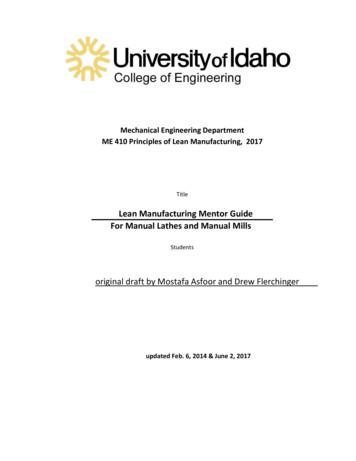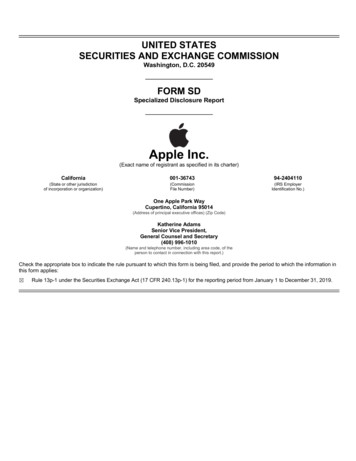WORK SHOP/MANUFACTURING PROCESS LABORATORY
WORK SHOP/MANUFACTURINGPROCESS LABORATORYLAB MANUALCourse Code:AMEB01Regulations:IARE – R18Semester:IBranch:AE CSE IT MEPrepared byMr. G MusalaiahAssistant ProfessorINSTITUTE OF AERONAUTICAL ENGINEERING(Autonomous)Dundigal, Hyderabad - 500 043
INSTITUTE OF AERONAUTICAL ENGINEERING(Autonomous)Dundigal, Hyderabad – 500043Program ineering knowledge: Capability to apply the knowledge of Mathematics, science andEngineering in the field of Mechanical Engineering.Problem analysis: An Ability to analyze complex engineering problems to arrive at relevantconclusions using knowledge of Mathematics, Science and Engineering.Design/development of solutions: Competence to design a system, component or process to meetsocietal needs within realistic constraints.Conduct investigations of complex problems: To design and conduct research orientedexperiments as well as to analyze and implement data using research methodologies.Modern tool usage: An ability to formulate solve complex engineering problem using modernengineering and Information technology tools.The engineer and society: To utilize the engineering practices, techniques, skills to meet needs ofthe health, safety, legal, cultural and societal issues.Environment and sustainability: To understand impact of engineering solutions in the societalcontext and demonstrate the knowledge for sustainable development.Ethics: An understanding and implementation of professional and Ethical responsibilities.Individual and team work: To function as an effective individual and as a member or leader inMulti-disciplinary environment and adopt in diverse teams.Communication: An ability to assimilate, comprehends, communicate, give and receiveinstructions to present effectively with engineering community and society.Project management and finance: An ability to provide leadership in managing complexengineering projects at multi-disciplinary environment and to become a professional engineer.Life-long learning: Recognition of the need and an ability to engage in lifelong learning tokeep abreast with technological changes.Program Specific OutcomesPSO1 Professional skills: Able to utilize the knowledge of aeronautical/aerospace engineering in innovative,dynamic and challenging environment for design and development of new products.PSO2 Professional skills: Imparted through simulation language skills and general purpose CAE packages to solvepractical, design and analysis problems of components to complete the challenge of airworthiness for flightvehicles.PSO3 Practical implementation and testing skills: Providing different types of in house and training and industrypractice to fabricate and test and develop the products with more innovative technologies.PSO4 Successful career and entrepreneurship: To prepare the students with broad aerospace knowledge to designand develop systems and subsystems of aerospace and allied systems and become technocrats.
INSTITUTE OF AERONAUTICAL ENGINEERING(Autonomous)Dundigal, Hyderabad – 500043ATTAINMENT OF PROGRAM OUTCOMES& PROGRAM SPECIFIC OUTCOMESS No1234567891011121314ExperimentMACHINE SHOP-TURNING AND OTHERMACHINESMACHINE SHOP-MILLING AND OTHERMACHINESADVANCED MACHINE SHOPFITTINGCARPENTRY-ICARPENTRY-IIELECTRICAL AND ELECTRONICSWELDINGMOULD PREPARATIONMOULD PREPARATIONBLACKSMITHY- I, TINSMITHY- ITINSMITHY- I, BLACKSMITHY- IPLASTIC MOULDING, INJECTIONMOULDING, GLASS CUTTINGBLOW MOULDINGProgram OutcomeAttainedPO1, PO2, PO3Program SpecificOutcomes AttainedPSO1, PSO3PO1, PO2, PO3PSO1, PSO3PO1, PO2, PO3PO2, PO3PO3, PO4PO2, PO3PO2, PO3PO2, PO3PO3, PO4PO3, PO4PO2, PO3PO2, PO3PO2, PO3PSO1, PSO3PSO1, PSO3PSO1, PSO3PSO1, PSO3PSO1, PSO3PSO1, PSO3PSO1, PSO3PSO1, PSO3PSO1, PSO3PSO1, PSO3PSO1, PSO3PO2, PO3PSO1, PSO3
INSTITUTE OF AERONAUTICAL ENGINEERING(Autonomous)Dundigal, Hyderabad - 500 043CertificateThis is to Certify that it is a bonafied record of Practical work done bySri/Kum.Roll No.bearing theofClassBranch in thelaboratory during the Academicyearunder our supervision.Head of the DepartmentLecture In-ChargeExternal ExaminerInternal Examiner4 Page
WORKSHOP/MANUFACTURING PROCESS LABORATORYI Semester: ME CSE IT AECourse CodeCategoryAMEB01FoundationContact Classes: NilTutorial Classes: NilHours / WeekLPT3CreditsC1.5Practical Classes: 48Maximum MarksCIASEE Total3070100Total Classes: 48COURSE OBJECTIVES:The course should enable the students to:I. Identify and use of tools, types of joints in carpentry, fitting, tin smithy and plumbing operations.II. Understand of electrical wiring and components.III. Observation of the function of lathe, shaper, drilling, boring, milling, grinding machines.COURSE OUTCOMES (COs):CO 1 : Explain different basic operations performed on lathe, drilling, grinding, milling, shapermachines.CO 2 : Understand the different parts of the CNC turning, drilling, milling machines etc.CO 3 : Identify the different joints used in carpentry, tin smithy, black smithy and fitting.CO 4 : Apply the basic drawing for circuit diagrams used in house wiring.CO 5 : Identify the different types of welding, moulding, glass cutting methods.COURSE LEARNING OUTCOMES (CLOs):The students should enable to:1. To identify different Tools required for Wood working.2. Familiarize the students to different cutting fluids.3. Use of Cutting tools required for Metal working in the Fitting work.4. Prepare Students for development of surfaces using the theory of Engineering Drawing andapplication of the same to the Tin Smithy.5. Need for heating of the Mild Steel and to understand the Hot Working of the metals in BlackSmithy.6. To prepare circuit diagrams for house working for Series and Parallel Connection.7. Understand the circuit connections for One Bulb connected with two way switches i.e., Stair Caseconnections.8. To prepare Mould preparation and demonstration Casting Process.9. Exposure for different types of solid state welding and other welding practices viz Arc welding,Gas welding, Brazing, Soldering etc .10. Introduce Students with new technology manufacturing practices like 3D Printing.11. Familiarize the students with the introduction of conventional machine tools like Lathe, Milling,Drilling etc.12. Demonstrate Manufacturing practices on CNC Machine tools.4 Page
LIST OF EXPERIMENTSWEEK - 1MACHINE SHOP-TURNING AND OTHER MACHINESBatch I: Working on central lathe and shaping machine.Batch II: Working on drilling, grinding machines.WEEK - 2MACHINE SHOP-MILLING AND OTHER MACHINESBatch I: Working on milling machine.Batch II: Working on milling and shaping machine.WEEK - 3ADVANCED MACHINE SHOPBatch I: Working on CNC Turning machines.Batch II: Working on CNC Vertical Drill Tap Center.WEEK - 4FITTINGBatch I: Make a straight fit and straight fit for given dimensions.Batch II: Make a square fit for straight fit for given sizes.WEEK - 5CARPENTRY-IBatch I: Preparation of lap joint as per given dimensions.Batch II: Preparation of dove tail joint as per given taper angleWEEK - 6CARPENTRY-IIBatch I: Preparation of dove tail joint as per given taper angle.Batch II: Preparation of lap joint as per given dimensions.WEEK - 7ELECTRICAL AND ELECTRONICSBatch I : Make an electrical connection to demonstrate domestic voltage and current sharing.Batch II: Make an electrical connection to control one bulb with two switches-stair case connection.WEEK - 8WELDINGBatch I: Arc welding & Gas Welding.Batch II: Gas welding & Arc Welding.WEEK - 9MOULD PREPARATIONBatch I: Prepare a wheel flange mould using a given wooden pattern.Batch II: Prepare a bearing housing using an aluminum pattern.WEEK - 10MOULD PREPARATIONBatch I: Prepare a bearing housing using an aluminum pattern.Batch II: Prepare a wheel flange mould using a given wooden pattern.WEEK - 11 BLACKSMITHY- I, TINSMITHY- I4 PageBatch I: Prepare S-bend & J-bend for given MS rod using open hearth furnace.Batch II: Prepare the development of a surface and make a rectangular tray and a round tin.
WEEK - 12TINSMITHY- I, BLACKSMITHY- IBatch I: Prepare the development of a surface and make a rectangular tray and a round tin.Batch II: Prepare S-bend & J-bend of given MS rod using open hearth furnace.WEEK - 13PLASTIC MOULDING, INJECTION MOULDING, GLASS CUTTINGBatch I: Plastic Moulding and Glass cutting.Batch II: Plastic Moulding and Glass cutting.WEEK - 14BLOW MOULDINGBatch I& II: Blow Moulding.Text Books:1 Hajra Choudhury S.K., Hajra Choudhury A.K. and Nirjhar Roy S.K., “Elements of WorkshopTechnology”, Vol. I 2008 and Vol. II 2010, Media promoters and publishers private limited,Mumbai.2 Kalpakjian S, Steven S. Schmid, “Manufacturing Engineering and Technology”, Pearson EducationIndia Edition, 4th Edition, 2002.Reference Books:1 Gowri P. Hariharan, A. Suresh Babu,” Manufacturing Technology – I”, Pearson Education, 2008.2 Roy A. Lindberg, “Processes and Materials of Manufacture”, Prentice Hall India, 4th Edition, 1998.3 Rao P.N., “Manufacturing Technology”, Vol. I and Vol. II, Tata McGraw-Hill House, 2017.Web References:1https://www.iare.ac.in4 Page
4 Page
4 Page
4 Page
4 Page
4 Page
4 Page
4 Page
4 Page
4 Page
4 Page
4 Page
4 Page
4 Page
4 Page
4 Page
4 Page
4 Page
4 Page
4 Page
4 Page
4 Page
4 Page
4 Page
4 Page
EXPERIMENT-02:AIM: To prepare a wiring to control two lamps connected in parallel by one switch.(PARALLEL CONNECTION)TOOLS REQUIRED:1. Screw driver2. Connector3. Tester4. Lamp holders5. One way switch6. Wires7. Wire clips8. Nails9. Pocker10. Bulbs11. Wire cutter12. Nose pliers13. Cutting pliers14. Ball peen hammerCIRCUIT DIAGRAM:4 Page
4 Page
EXPERIMENT-02:AIM: To prepare a wiring to control one lamp controlled by two way switch.TOOLS REQUIRED:1. Screw driver2. Connector3. Tester4. Lamp holders5. One way switch6. Wires, wire clips7. Nails8. Pocker9. Bulbs10. Wire cutter11. Nose pliers12. Cutting pliers13. Ball peen hammerCIRCUIT DIAGRAM:ONE LAMP CONTROLLED BY TWO WAY SWITCH4 Page
4 Page
4 Page
4 Page
4 Page
4 Page
4 Page
4 Page
4 Page
4 Page
4 Page
4 Page
4 Page
4 Page
4 Page
4 Page
4 Page
4 Page
4 Page
4 Page
4 Page
4 Page
4 Page
4 Page
4 Page
1 machine shop-turning and other machines po1, po2, po3 pso1, pso3 2 machine shop-milling and other machines po1, po2, po3 pso1, pso3 3 advanced machine shop po1, po2, po3 pso1, pso3 4 fitting po2, po3 pso1, pso3 5 carpentry-i po3, po4 pso1, pso3 6 carpentry-ii po2, po3 pso1, pso3 7 electrical and electronics po2, po3 pso1, pso3
IV. Shop Safety Page 1 of 19 Revised 2-Dec-14 IV. SHOP SAFETY 1.0 General Shop Safety 1.1 The hazards associated with shop work require special safety considerations. Whether you work in a metal shop, wood shop, automotive shop, glass shop, or electrical shop, the potential hazards for personal injury are numerous. This chapter
2. Shop Orientation and Safety Requirements Shop orientation precludes any shop use. Successful completion of the safety course precludes shop use. Demonstration of proficiency of select pieces of shop equipment precludes shop use. Shop users must sign and date a copy of the Shop Users Safety Agreement form.
Shop Orientation/Safety The first day of Lean Manufacturing is a shop orientation for the students. This is required for them to be shop certified so that they can work in the shop under a mentor’s guidance. The shop orientation checklist can be found on the Machine Shop website.
Callie Purple Imp. Callie Rose Callie Rose Dark Center Callie Star Orange Callie Strawberry Callie White Callie Yellow Candy Shop Candy Bouquet Candy Shop Candy Crush Candy Shop Chocolate Candy Shop Fancy Berry Candy Shop Grape Splash Candy Shop Sweet Dreams Chameleon Atomic Orange Cham
The Auto Shop and Safety After studying this chapter, you will be able to: Describe the typical layout and sections of an auto shop. List the types of accidents that can occur in an auto shop. Explain how to prevent auto shop accidents. Describe general safety rules for the auto shop. An auto
4. Providing the shop with the resources necessary to comply with health and safety policies and guidelines. Shop Supervisor The Shop Supervisor plays a key role in the implementation of the shop's safety program. They are responsible for: 1. Encouraging and promoting a healthy safety culture within the shop; 2. Modeling and enforcing safe .
BARBER SHOP PERMIT APPLICATION INSTRUCTIONS 1. BARBER SHOP NAME - Write the name of your barber shop as it should appear on your barber shop permit. (maximum of 40 characters) 2. BARBER SHOP'S MAILING ADDRESS - Write your current business mailing address. This is the address where we will send you mail. This address can be a post office box.
Section 1 – Conflict Minerals Disclosure Items 1.01 and 1.02 Conflict Minerals Disclosure and Report, Exhibit Conflict Minerals Disclosure A copy of Apple Inc.’s (“Apple’s”) Conflict Minerals Report for the reporting period January 1, 2019 to December 31, 2019 is provided as























